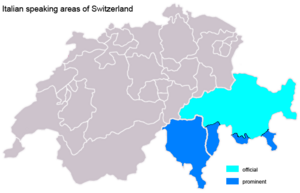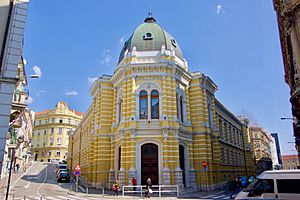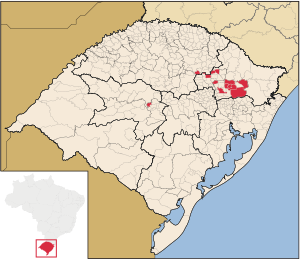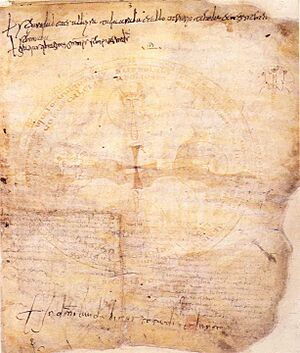Italian language facts for kids
Quick facts for kids Italian |
|
|---|---|
| italiano, lingua italiana | |
| Native to | Italy, San Marino, Vatican City, Switzerland, Slovenia (Slovenian Littoral), Croatia (Western Croatia) |
| Ethnicity | Italians |
| Native speakers | L1: 65 million (2022)e25 L2: 3.1-21 million Total: 85 million |
| Language family | |
| Dialects |
Maltese Italian
Swiss Italian
Various forms of regional Italian
|
| Writing system | Latin script (Italian alphabet) Italian Braille |
| Official status | |
| Official language in |
4 countries
2 regions
Various organisations and orders
Sovereign Military Order of Malta
European Union FAO Holy See OSCE IDLO IIHL Mediterranean Universities Union UNICRI UNIDROIT and others |
| Recognised minority language in |
5 countries
|
| Regulated by | Accademia della Crusca (de facto) |
| Linguasphere | 51-AAA-q |
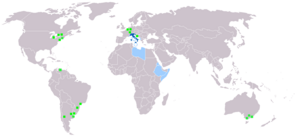
Geographical distribution of the Italian language in the world:
Areas where it is the majority language Areas where it is a minority language or where it was a former colonial language Areas where notable Italian-speaking communities are present |
|
Italian (called italiano in Italian) is a beautiful Romance language. It comes from the everyday Latin spoken in the Roman Empire a long, long time ago. Italian is very similar to Latin, even more so than most other Romance languages.
Today, about 68 to 85 million people speak Italian. Around 64 million of them speak it as their first language. Many people in Italy speak both standard Italian and a local language from their home region.
Italian is an official language in Italy, San Marino, Switzerland, and Vatican City. It is also recognized as a minority language in parts of Croatia, Slovenia, Romania, Bosnia and Herzegovina, and even in some towns in Brazil. You can also find Italian speakers in countries like Malta, Albania, and Monaco, and in many communities around the world, including the Americas and Australia.
Italian is important in Europe. It is one of the official languages of the European Union. It is also the main language used by the Holy See (the government of the Catholic Church). Many Italian words are used internationally, especially in music (like opera), fashion, cooking, and art. Most Italian words end with a vowel sound. The language also has special sounds with short and long (or doubled) consonants.
Contents
Discovering the Italian Language
Where is Italian Spoken?
Italian is the official language in Italy and San Marino, where most people speak it. It is also one of the official languages in Switzerland, especially in the Ticino region. The Vatican City also uses Italian for its official documents.
You can find Italian speakers in other European countries too. In Malta, about two-thirds of the people speak Italian. It is also spoken in Albania and Monaco. Historically, Italian was spoken in parts of France, Slovenia, and Croatia, and it is still a recognized minority language in these areas.
Italian also spread around the world because many Italians moved to other countries. Large communities of Italian speakers live in the Americas (like Argentina, Brazil, Canada, United States, and Venezuela) and Australia. In some places, like Rio Grande do Sul in Brazil, people still speak special forms of Italian that developed from the languages their ancestors brought.
Learning Italian Around the World
Many students worldwide choose to learn Italian. Over 200,000 foreign students study Italian each year. They learn it at Italian Cultural Institutes or in Italian schools abroad.
Technology helps too! Websites and apps like Duolingo make it easy for millions of people to learn Italian at their own pace. As of 2022, Australia had the most students learning Italian, thanks to support from the Italian community and government.
How Italian Influenced Other Languages
Italian has influenced many languages, especially in areas like art, music, fashion, and cooking. Think of words like pizza, spaghetti, opera, piano, and ballet – these are all Italian words used around the world!
When millions of Italians moved to other countries, they also influenced local languages. For example, in Argentina and Uruguay, the local Spanish dialects have many words and sounds from Italian. In some places, new languages even formed, like Talian in Brazil.
Italian was also a very important language for trade and culture in Europe during the Middle Ages and Renaissance. Educated people would often learn Italian, especially when traveling to Italy on a "Grand Tour" to see its famous art and history.
A Journey Through Italian History
How Italian Began
The Italian language did not appear overnight. It slowly grew from Vulgar Latin, which was the everyday language spoken by people in the Roman Empire. After the Roman Empire ended around the 5th century, this Latin started changing in different parts of Italy.
These local ways of speaking Latin eventually became what we now call the "Romance dialects" of Italy. They are like sister languages to modern Italian, not just different versions of it. The very first written examples of these early Italian languages appeared around the 9th and 10th centuries.
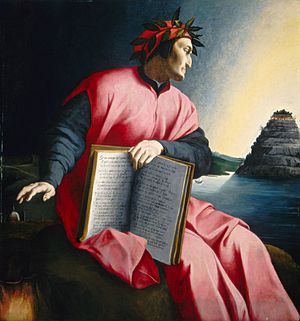
The language we know as standard Italian today came from the Florentine dialect spoken in Florence, a city in Tuscany. A very famous writer named Dante Alighieri helped make this dialect important in the early 1300s. His epic poem, the Divine Comedy, was read all over Italy. Because of Dante's work, the Florentine way of speaking became a model for educated Italians. Other poets like Petrarch also helped make this literary language popular.
The Renaissance and Printing
The Renaissance (meaning "rebirth") was a time of great change in Italy, starting in the 14th century. People became very interested in old classical writings and new literature.
A big invention, the printing press, arrived in the 15th century. By 1500, Italy had more printing presses than any other country in Europe. This meant books and documents could be made faster and cheaper. The printing press helped spread the Italian language even more.
Italian became the official language in many Italian states, slowly replacing Latin. Even when foreign rulers governed parts of Italy, Italian was often used.
Italian in Modern Times
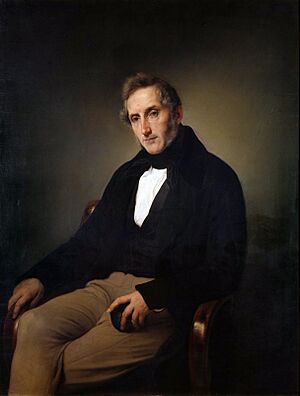
In the 19th century, Italy was unified into one country. A famous writer named Alessandro Manzoni wrote a novel called The Betrothed (I promessi sposi). He chose to write it in the Florentine dialect, which helped make this dialect the standard for the whole country. His book became very popular and helped bring Italians together through a common language.
Even after Italy became one country, many people still spoke their local dialects. In 1861, only a small percentage of Italians could speak standard Italian well. However, as more people learned to read and write, and with the help of newspapers, radio, and television, standard Italian became much more common.
Today, while standard Italian is spoken everywhere, you can still hear many different regional accents and local languages across Italy. For example, the way people say "all right" (va bene) can sound different in Rome compared to Milan.
How Italian Sounds and is Written
The Italian Alphabet and Spelling
The Italian alphabet usually has 21 letters. It uses the Latin script. Letters like J, K, W, X, and Y are not usually found in native Italian words, but you might see them in words borrowed from other languages, like jeans or taxi.
Italian spelling is quite regular. This means that letters usually make the same sound, which makes it easier to read and write. For example, the letter 'h' is always silent in Italian, like in hotel.
Here are some special spelling rules:
- The letter 'c' sounds like the 'ch' in chair before 'e' or 'i' (e.g., cena - dinner). Before 'a', 'o', 'u', or at the end of a word, it sounds like the 'k' in cat (e.g., casa - house).
- The letter 'g' sounds like the 'j' in jump before 'e' or 'i' (e.g., gente - people). Before 'a', 'o', 'u', or at the end of a word, it sounds like the 'g' in go (e.g., gatto - cat).
- To keep the 'k' sound before 'e' or 'i', Italians add an 'h' (e.g., che - what, chi - who).
- To keep the 'g' sound before 'e' or 'i', they also add an 'h' (e.g., ghetto - ghetto).
- Double consonants, like 'nn' in anno (year), are pronounced longer and stronger than single consonants.
Understanding Italian Sounds
Italian has seven main vowel sounds, even though it only uses five vowel letters (a, e, i, o, u). The letters 'e' and 'o' can have two different sounds each, one more open and one more closed. For example, pesca can mean "fishing" (with an open 'e') or "peach" (with a closed 'e').
Italian also has diphthongs, which are two vowel sounds blended together, like uo in buono (good) or ie in ieri (yesterday).
A special feature of Italian is its double consonants. When you see two of the same consonant together (like 'tt' in gatto), you pronounce them longer and with more emphasis than a single consonant. This can change the meaning of a word!
Italian Grammar Basics
Italian grammar is similar to other Romance languages. It has two genders for nouns: masculine and feminine.
Nouns and Genders
Most masculine nouns end in -o in the singular and -i in the plural (e.g., ragazzo (boy) becomes ragazzi (boys)). Most feminine nouns end in -a in the singular and -e in the plural (e.g., ragazza (girl) becomes ragazze (girls)). Some nouns end in -e in the singular and -i in the plural, and can be either masculine or feminine (e.g., fiume (river) is masculine, legge (law) is feminine).
Here are some examples:
| Definition | Gender | Singular Form | Plural Form |
|---|---|---|---|
| Son | Masculine | Figlio | Figli |
| House | Feminine | Casa | Case |
| Love | Masculine | Amore | Amori |
| Art | Feminine | Arte | Arti |
Adjectives and Articles
Adjectives (words that describe nouns) also change their endings to match the gender and number of the noun they describe.
Italian uses articles (like "a," "an," "the") just like English, but there are more forms. The article changes depending on the gender and number of the noun, and even on the first letter of the noun. For example, "the" can be il, lo, la, or l' in the singular, and i, gli, or le in the plural.
Verbs and Pronouns
Italian verbs change their endings depending on who is doing the action (I, you, he/she, we, you all, they). This means you often don't need to say the pronoun (like "I" or "he") because the verb ending tells you who the subject is. For example, amo means "I love."
There are also different ways to say "you" in Italian: an informal tu for friends and family, and a formal Lei for adults you don't know well or people you want to show respect to.
Learning Italian Words and Phrases
Here are some common Italian words and phrases to help you get started!
Everyday Conversations
| English (inglese) | Italian (italiano) | Pronunciation |
|---|---|---|
| Yes | Sì | (listen) |
| No | No | (listen) |
| Of course! | Certo! / Certamente! / Naturalmente! | |
| Hello! | Ciao! (informal) / Salve! (semi-formal) | |
| Cheers! | Salute! | |
| How are you? | Come stai? (informal) / Come sta? (formal) / Come state? (plural) / Come va? (general, informal) | |
| Good morning! | Buongiorno! (= Good day!) | |
| Good evening! | Buonasera! | |
| Good night! | Buonanotte! (for a good night sleeping) / Buona serata! (for a good night awake) | |
| Have a nice day! | Buona giornata! (formal) | |
| Enjoy the meal! | Buon appetito! | |
| Goodbye! | Arrivederci (general) / Arrivederla (formal) / Ciao! (informal) | (listen) |
| Good luck! | Buona fortuna! (general) | |
| I love you | Ti amo (between lovers only) / Ti voglio bene (in the sense of "I am fond of you", between lovers, friends, relatives etc.) | |
| Welcome [to...] | Benvenuto/-i (for male/males or mixed) / Benvenuta/-e (for female/females) [a / in...] | |
| Please | Per favore / Per piacere / Per cortesia | (listen) |
| Thank you! | Grazie! (general) / Ti ringrazio! (informal) / La ringrazio! (formal) / Vi ringrazio! (plural) | |
| You are welcome! | Prego! | |
| Excuse me / I am sorry | Mi dispiace (only "I am sorry") / Scusa(mi) (informal) / Mi scusi (formal) / Scusatemi (plural) / Sono desolato ("I am sorry", if male) / Sono desolata ("I am sorry", if female) | |
| Yes, I understand. | Sì, capisco. / Ho capito. | |
| I do not understand. | Non capisco. / Non ho capito. | (listen) |
| Do you speak English? | Parli inglese? (informal) / Parla inglese? (formal) / Parlate inglese? (plural) | (listen) (listen) |
| I do not understand Italian. | Non capisco l'italiano. | |
| Help me! | Aiutami! (informal) / Mi aiuti! (formal) / Aiutatemi! (plural) / Aiuto! (general) | |
| You are right/wrong! | (Tu) hai ragione/torto! (informal) / (Lei) ha ragione/torto! (formal) / (Voi) avete ragione/torto! (plural) | |
| What time is it? | Che ora è? / Che ore sono? | |
| Where is the bathroom? | Dov'è il bagno? | (listen) |
| How much is it? | Quanto costa? | |
| The bill, please. | Il conto, per favore. | |
| The study of Italian sharpens the mind. | Lo studio dell'italiano aguzza l'ingegno. | |
| Where are you from? | Di dove sei? (general, informal)/ Di dove è? (formal) | |
| I like | Mi piace (for one object) / Mi piacciono (for multiple objects) |
Asking Questions
| English | Italian |
|---|---|
| what (adj.) | che |
| what (standalone) | cosa |
| who | chi |
| how | come |
| where | dove |
| why, because | perché |
| which | quale |
| when | quando |
| how much | quanto |
Telling Time
| English | Italian |
|---|---|
| today | oggi |
| yesterday | ieri |
| tomorrow | domani |
| second | secondo |
| minute | minuto |
| hour | ora |
| day | giorno |
| week | settimana |
| month | mese |
| year | anno |
Counting in Italian
|
|
|
| English | Italian |
|---|---|
| one hundred | cento |
| one thousand | mille |
| two thousand | duemila |
| two thousand (and) twenty-five (2025) | duemilaventicinque |
| one million | un milione |
| one billion | un miliardo |
| one trillion | mille miliardi |
Days and Months
| English | Italian |
|---|---|
| Monday | lunedì |
| Tuesday | martedì |
| Wednesday | mercoledì |
| Thursday | giovedì |
| Friday | venerdì |
| Saturday | sabato |
| Sunday | domenica |
| English | Italian |
|---|---|
| January | gennaio |
| February | febbraio |
| March | marzo |
| April | aprile |
| May | maggio |
| June | giugno |
| July | luglio |
| August | agosto |
| September | settembre |
| October | ottobre |
| November | novembre |
| December | dicembre |
Example Text
Here is Article 1 of the Universal Declaration of Human Rights in Italian:
- Tutti gli esseri umani nascono liberi ed eguali in dignità e diritti. Essi sono dotati di ragione e di coscienza e devono agire gli uni verso gli altri in spirito di fratellanza.
And in English, it means:
- All human beings are born free and equal in dignity and rights. They are endowed with reason and conscience and should act towards one another in a spirit of brotherhood.
Famous Italian Writers
Many Italian writers have won the Nobel Prize in Literature for their amazing works. Here are some of them:
| Year | Image | Laureate | Born | Died | Field | Rationale |
|---|---|---|---|---|---|---|
| 1906 | 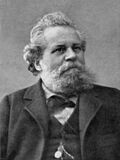 |
Giosuè Carducci | 27 July 1835 in Valdicastello | 16 February 1907 in Bologna | Literature | "for his deep learning and critical research, and for the creative energy, freshness of style, and lyrical force in his poetic masterpieces" |
| 1926 | 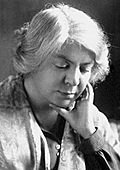 |
Grazia Deledda | 27 September 1871 in Nuoro | 15 August 1936 in Rome | Literature | "for her writings that clearly show life on her native island of Sardinia and deal with human problems with depth and sympathy" |
| 1934 | 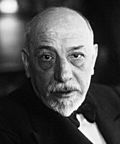 |
Luigi Pirandello | 28 June 1867 in Agrigento | 10 December 1936 in Rome | Literature | "for his bold and clever way of bringing new life to dramatic and stage art" |
| 1959 | 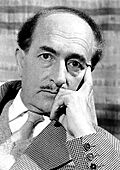 |
Salvatore Quasimodo | 20 August 1901 in Modica | 14 June 1968 in Naples | Literature | "for his lyrical poetry, which with classical passion expresses the tragic experience of life in our own times" |
| 1975 | 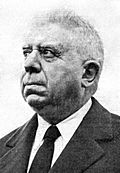 |
Eugenio Montale | 12 October 1896 in Genoa | 12 September 1981 in Milan | Literature | "for his unique poetry which, with great artistic feeling, has shown human values with a realistic view of life" |
| 1997 |  |
Dario Fo | 24 March 1926 in Leggiuno-Sangiano | 13 October 2016 in Milan | Literature | "who acts like the jesters of the Middle Ages in criticizing authority and supporting the dignity of those who are struggling" |
See also
 In Spanish: Idioma italiano para niños
In Spanish: Idioma italiano para niños
- Languages of Italy
- Italian alphabet
- Regional Italian
- Italian grammar
- List of countries and territories where Italian is an official language
- Italian language in Brazil
- Italian language in Croatia
- Italian language in Slovenia
- Italian language in the United States
- Italian literature
- Italian musical terms
- Italian phonology
- Italian Sign Language
- Veronese Riddle
- Languages of the Vatican City
- Talian
- List of English words of Italian origin
- List of Italian musical terms used in English


